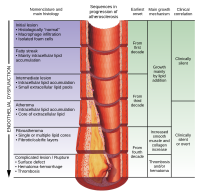
Photo from wikipedia
Atherosclerotic renovascular disease is the most frequent cause of renovascular hypertension and its prevalence increases with age and in specific subset of patients, such as those with end-stage chronic kidney… Click to show full abstract
Atherosclerotic renovascular disease is the most frequent cause of renovascular hypertension and its prevalence increases with age and in specific subset of patients, such as those with end-stage chronic kidney disease, heart failure, and coronary artery disease. Besides hypertension, atherosclerotic renovascular disease is responsible for several clinical manifestations, including life-threatening conditions, such as recurrent flash pulmonary edema, rapidly progressive chronic kidney disease, or acute kidney injury. Atherosclerotic renovascular disease is usually part of a more diffuse atherosclerotic process and requires a combination therapy including antihypertensive, antiplatelet and lipid-lowering agents, as well as optimization of antidiabetic treatment, if needed. Besides medical therapy, percutaneous renal angioplasty was supposed to be the most effective therapy for atherosclerotic renovascular disease, by leading to blood flow restoration. However, despite an apparently solid rationale, several randomized clinical trials failed to confirm the favorable effects of percutaneous renal angioplasty on blood pressure control, kidney function, cardiovascular and renal outcomes, previously reported in observational, retrospective and single-center cohorts, switching off the enthusiasm for this procedure. Several studies' limitations may partly account for this failure, including heterogeneity of diagnostic techniques, overestimation of the degree of renal artery stenosis, inappropriate timing of revascularization, multiple protocol revisions, frequent crossovers, and most importantly exclusion of patients at higher likelihood to respond to angioplasty. The purpose of this review is to summarize studies' potential weaknesses and provide guidance to the clinician for identification of patients who may benefit most from revascularization.
Journal Title: Hypertension
Year Published: 2023
Link to full text (if available)
Share on Social Media: Sign Up to like & get
recommendations!